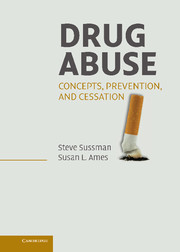Book contents
- Frontmatter
- Contents
- Preface
- Acknowledgments
- SECTION ONE CONCEPTS AND CLASSES OF DRUGS
- SECTION TWO ETIOLOGY
- 4 Current Multivariable Models
- 5 Neurobiologically Relevant
- 6 Cognitive Processes
- 7 Social Interaction and Social Groups
- 8 The Large Social and Physical Environment
- 9 Assessment
- SECTION THREE PREVENTION
- SECTION FOUR CESSATION
- SECTION FIVE CONCLUSIONS AND THE FUTURE
- References
- Author Index
- Subject Index
7 - Social Interaction and Social Groups
Published online by Cambridge University Press: 18 December 2009
- Frontmatter
- Contents
- Preface
- Acknowledgments
- SECTION ONE CONCEPTS AND CLASSES OF DRUGS
- SECTION TWO ETIOLOGY
- 4 Current Multivariable Models
- 5 Neurobiologically Relevant
- 6 Cognitive Processes
- 7 Social Interaction and Social Groups
- 8 The Large Social and Physical Environment
- 9 Assessment
- SECTION THREE PREVENTION
- SECTION FOUR CESSATION
- SECTION FIVE CONCLUSIONS AND THE FUTURE
- References
- Author Index
- Subject Index
Summary
This chapter examines small group-level effects on individuals that may facilitate drug use. Small group interactions involve verbal (word content and intonation) and nonverbal (body language) behavioral exchanges. Each member of the group interprets the meaning of the interactions that transpire, and these perceptions of interactions that occur may differ across group members. Therefore, a distinction between perceived or egocentric social phenomena and observed, group-level social phenomena is generally recognized (e.g., as in smoking; Hoffman, Sussman, Unger, & Valente, 2006). The topics presented in this chapter include possible egocentric and group-level effects on drug use. The topics presented include the family unit and parenting, peer social influence, social learning, social support, social networks, deviant subcultures, and group identification.
The Family Unit and Parenting
Youth begin or do not begin to have drug-related experiences through parental and older sibling discussions of use and modeling of use (Flay et al., 1994). In addition, family interactions may serve to facilitate later drug use or protect against later use. Youth from single-parent homes, or those who spend relatively less time with parents or guardians (latch-key children), are relatively likely to use drugs later on (Dwyer et al., 1990; Griffin et al., 2000; Richardson et al., 1989). These findings are remarkable and require careful consideration, given the increasing number of single-parent homes in the United States (and several other countries), as well as households where it is necessary for all adults in the home to work.
- Type
- Chapter
- Information
- Drug AbuseConcepts, Prevention, and Cessation, pp. 98 - 108Publisher: Cambridge University PressPrint publication year: 2008



